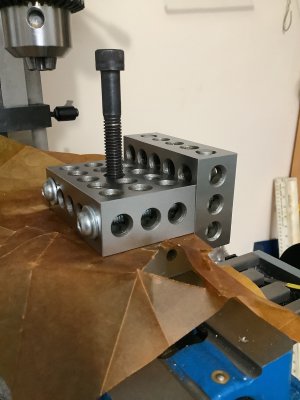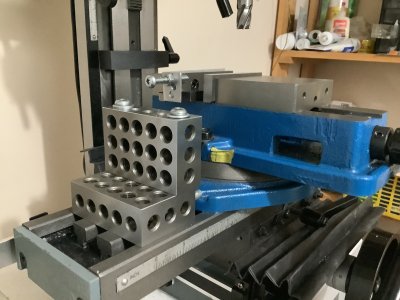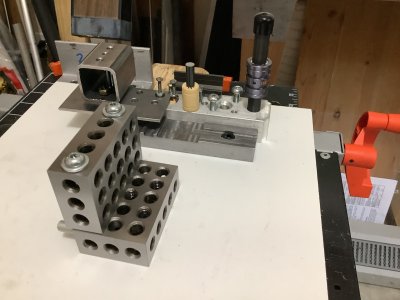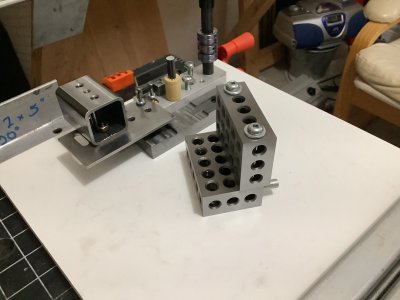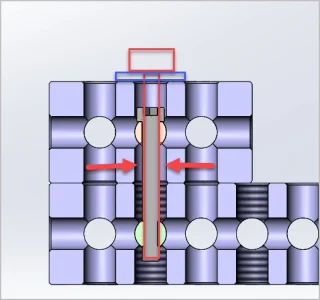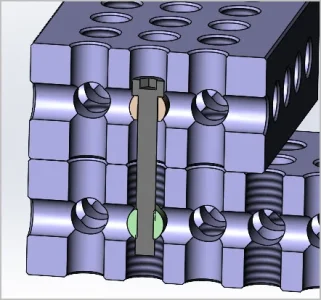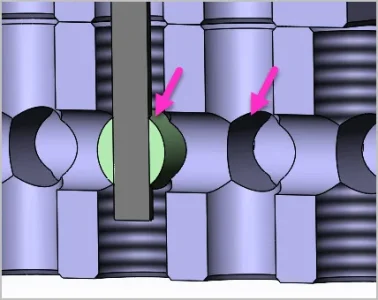-
Scam Alert. Members are reminded to NOT send money to buy anything. Don't buy things remote and have it shipped - go get it yourself, pay in person, and take your equipment with you. Scammers have burned people on this forum. Urgency, secrecy, excuses, selling for friend, newish members, FUD, are RED FLAGS. A video conference call is not adequate assurance. Face to face interactions are required. Please report suspicions to the forum admins. Stay Safe - anyone can get scammed.
You are using an out of date browser. It may not display this or other websites correctly.
You should upgrade or use an alternative browser.
You should upgrade or use an alternative browser.
WEN 123 Blocks - Sale
- Thread starter LenVW
- Start date
Tom Kitta
Ultra Member
Same price as on Amazon with free shipping.
These are actually very nice 1-2-3 blocks - I ordered 2 pairs sometime back. I measured them and they are very precise - they are within 0.01mm stated.
These are actually very nice 1-2-3 blocks - I ordered 2 pairs sometime back. I measured them and they are very precise - they are within 0.01mm stated.
chip4charlie
Well-Known Member
Here's a Stumpy Nubs Youtube video about a kit to connect 1-2-3 blocks together.
Sold by Tay Tools, who also sells blemished PEC stuff (rumor is PEC makes combination squares for a Japanese company starting with M and ending with O).I work mostly in metric, and found KBC the only one with 25-50-100 mm blocks (25-50-75 are easy to find)
Can you still get them from Amazon ?I have a set of the WEN blocks (paid $21.98 at the time from amazon) that I use for welding setup lol
Yes, Tom's link has them for $24/prCan you still get them from Amazon ?
SomeGuy
Hobbyist
Can you still get them from Amazon ?
Not for the $21.98 I paid, that was just the price at the time. Like everything else, they've gone up.
VicHobbyGuy
Ultra Member
Tay Tools has some interesting products - I put a few things in my shopping cart there, but things came to a screeching halt with the $65 USD shipping charge.Sold by Tay Tools
These WEN 123 Blocks are accurate enough for setups on the mill that require additional support beyond my VEVOR 3” mill vise.
Good ground finish and suitable array of holes to bolt the blocks into various arrangements.
Good ground finish and suitable array of holes to bolt the blocks into various arrangements.
Attachments
SomeGuy
Hobbyist
The Wen 25-50-75 blocks are on for as low as they've ever been:
Was it metric you were specifically after for some reason? (they offer inch for about the same cost). Are these of the 'unique' style that you cant pass the bolt through the alternate (unthreaded) holes?
Hard to judge by picture but seems that way

These are clones of the ones you can assemble (ie. clearance holes). They came up in conversation with a buddy of mine who has the equipment to measure them accurately & said they were well within stated spec. Now are the Wednesday models the same, who knows. Sorry for interjecting on the post but just pointing out some options.
Hard to judge by picture but seems that way
These are clones of the ones you can assemble (ie. clearance holes). They came up in conversation with a buddy of mine who has the equipment to measure them accurately & said they were well within stated spec. Now are the Wednesday models the same, who knows. Sorry for interjecting on the post but just pointing out some options.
I use 5/16” Barrel Nuts to tie the blocks together.Was it metric you were specifically after for some reason? (they offer inch for about the same cost). Are these of the 'unique' style that you cant pass the bolt through the alternate (unthreaded) holes?
Hard to judge by picture but seems that way
View attachment 28731
These are clones of the ones you can assemble (ie. clearance holes). They came up in conversation with a buddy of mine who has the equipment to measure them accurately & said they were well within stated spec. Now are the Wednesday models the same, who knows. Sorry for interjecting on the post but just pointing out some options.
Works slick with a 1/4”-20 tapped hole in the middle.
Ya I did something similar. It 'works' but I don't feel its as stable as the 'original' blocks with matching clearance/threaded holes. Might be due to my round nut in a round hole making tangent-tangent contact. People have come up with various workarounds over the years. But seems like clones of originals are now more plentiful for a few buck more. A few years back they were only offered as 'matched sets' for quite a bit more $/block equivalent.
When you use the Barrel Nut and Tie-Rod bolt assembly the contact between the block faces is what results in a ‘square’ set-up reference plane. The round tangential interaction of the barrel nut in the hole is just an ‘anchor’ to create the fastening effect.
If you need a more accurrate set-up, you should look at Jig Boring Mills. We used to use them to quantify ASME Test Specimens for research labs.
They are an expensive option for us hobbyists ($400/hr).
If you need a more accurrate set-up, you should look at Jig Boring Mills. We used to use them to quantify ASME Test Specimens for research labs.
They are an expensive option for us hobbyists ($400/hr).
Attachments
Len, one of the fixes I tried to make the clone blocks act somewhat like the Renzetti blocks is shown in cross section. I have a cross stud (orange) with 8-32 bolt which taps into the same thing what you call a barrel nut (green). The idea was to not only clamp a multi block fixture assembly on any available hole, but also, there would be no exposed fastener heads or hardware on any surface. Not a need to have often, but a nice to have.
Using a similar sketch, if I understand your assembly, you run a longer length bolt into the barrel nut & use a washer between the head & block. It is providing clamping force between the 2 block faces, but its the same issue. There is clearance between the bolt shank & hole (red arrow) and the anchor contact is essentially a tangent line (pink arrow). Its this combination that makes it a bit less secure setup as opposed to threading a stud into the block itself (as the original 123 blocks were intended). Hope this makes sense
Using a similar sketch, if I understand your assembly, you run a longer length bolt into the barrel nut & use a washer between the head & block. It is providing clamping force between the 2 block faces, but its the same issue. There is clearance between the bolt shank & hole (red arrow) and the anchor contact is essentially a tangent line (pink arrow). Its this combination that makes it a bit less secure setup as opposed to threading a stud into the block itself (as the original 123 blocks were intended). Hope this makes sense
Attachments
With the (2) 1/4”-20 UNC ‘Tie Bolts’ the faces of my blocks are held face to face with more 5000 lbs of force.
That is based on using Grade 5 HHCS.
** That suits my applications just fine **
I had assembled the blocks with the Button Head machine screws in the photo just for fit-ups.
That is based on using Grade 5 HHCS.
** That suits my applications just fine **
I had assembled the blocks with the Button Head machine screws in the photo just for fit-ups.
Yup, the bolt tension force is common to both our systems, no argument there. What I'm trying to say is the barrel nut is resolving the force on a tangent line between the barrel OD & block hole ID. the barrel nut also allows a bit of free play of the smaller diameter bolt within the holes until the bolt is tightened & the stud 'straightens out'. Your top washer is acting a bit like a self-alignment devise to make the stud orient more perpendicular as its tightened, which is a good thing.
My attempt at keeping the fasteners entirely hidden, unfortunately uses 2 barrel nut equivalents. Now we have 2 wiggly's not just one where all that force is resolved to 2 teeny contact tangent lines. And the drilled hole condition is not all that great. Anyways, I wanted to see if I could mimic a Renzetti style where block assemblies can one another in a multitude of flush orientations. In real life my attempt was fiddly & basically a fail IMO. Despite having lots of clamping force.
Real or conventional 123 blocks have a proper clearance hole sized relative to the threaded hole. The clone blocks failed to understand that detail apparently because you cant pass the stud through the open hole. I think they banged them all out with a tap drill & threaded every odd one. Anyways, the tapped hole more or less confines the stud to self-stand straight so its already perpendicular to the other block. There is no (or nil) initial axial freedom of the stud. The matching close fitting clearance hole serves to limit movement in the displacement direction. Conventional blocks still use 'proud' fasteners so there is difference in that respect. Hope this helps explain.

My attempt at keeping the fasteners entirely hidden, unfortunately uses 2 barrel nut equivalents. Now we have 2 wiggly's not just one where all that force is resolved to 2 teeny contact tangent lines. And the drilled hole condition is not all that great. Anyways, I wanted to see if I could mimic a Renzetti style where block assemblies can one another in a multitude of flush orientations. In real life my attempt was fiddly & basically a fail IMO. Despite having lots of clamping force.
Real or conventional 123 blocks have a proper clearance hole sized relative to the threaded hole. The clone blocks failed to understand that detail apparently because you cant pass the stud through the open hole. I think they banged them all out with a tap drill & threaded every odd one. Anyways, the tapped hole more or less confines the stud to self-stand straight so its already perpendicular to the other block. There is no (or nil) initial axial freedom of the stud. The matching close fitting clearance hole serves to limit movement in the displacement direction. Conventional blocks still use 'proud' fasteners so there is difference in that respect. Hope this helps explain.

